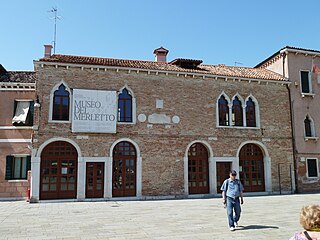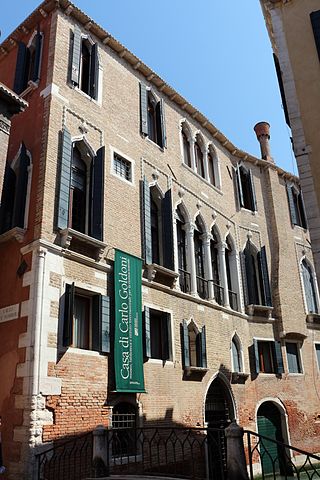
Murano is a series of islands linked by bridges in the Venetian Lagoon, northern Italy. It lies about 1.5 km (1 mi) north of Venice and measures about 1.5 km (1 mi) across with a population of just over 5,000. It is famous for its glass making. It was once an independent comune, but is now a frazione of the comune of Venice.

Venetian glass is glassware made in Venice, typically on the island of Murano near the city. Traditionally it is made with a soda–lime "metal" and is typically elaborately decorated, with various "hot" glass-forming techniques, as well as gilding, enamel, or engraving. Production has been concentrated on the Venetian island of Murano since the 13th century. Today Murano is known for its art glass, but it has a long history of innovations in glassmaking in addition to its artistic fame—and was Europe's major center for luxury glass from the High Middle Ages to the Italian Renaissance. During the 15th century, Murano glassmakers created cristallo—which was almost transparent and considered the finest glass in the world. Murano glassmakers also developed a white-colored glass that looked like porcelain. They later became Europe's finest makers of mirrors.

The Museo Correr is a museum in Venice, northern Italy. Located in St. Mark's Square, Venice, it is one of the 11 civic museums run by the Fondazione Musei Civici di Venezia. The museum extends along the southside of the square on the upper floors of the Procuratorie Nuove. With its rich and varied collections, the Museo Correr covers both the art and history of Venice.

Museo di Storia Naturale di Venezia is a museum of natural history housed in Fondaco dei Turchi, located on the Grand Canal, Venice, Italy. Its collections relate mainly to the natural history of the Venetian lagoon that surrounds the city. Today it is one of the 11 venues managed by the Fondazione Musei Civici di Venezia.

Pauly & C. - Compagnia Venezia Murano is one of the oldest glass factories of Murano: it was founded more than 150 years ago. The company produces glass art, most notably Roman murrine, mosaics and chandeliers.

The Civic Museums of Pavia are a number of museums in Pavia, Lombardy, northern Italy. They are housed in the Castello Visconteo, or Visconti Castle, built in 1360 by Galeazzo II Visconti, soon after taking the city, a free city-state until then. The credited architect is Bartolino da Novara. The castle used to be the main residence of the Visconti family, while the political capital of the state was Milan. North of the castle a wide park was enclosed, also including the Certosa of Pavia, founded 1396 according to a vow of Gian Galeazzo Visconti, meant to be a sort of private chapel of the Visconti dynasty. The Battle of Pavia (1525), climax of the Italian Wars, took place inside the castle park.

The Museo di Palazzo Mocenigo is a palazzo near the Church of San Stae, south of the Grand Canal in the sestiere of Santa Croce in Venice, Italy. It is now a museum of fabrics and costumes, run by the Fondazione Musei Civici di Venezia.

The Museo Fortuny or Fortuny Museum is an art museum in San Marco, in central Venice, Italy.
Founded following the resolution passed by the Municipal Council Board of Venice on March 3, 2008, the Fondazione Musei Civici di Venezia (MUVE) manages and develops the cultural and artistic heritage of Venice and islands. Formed as a participatory foundation, it has only one founding member, the City of Venice.

The Lace Museum is located at the historic palace of Podestà of Torcello, in Galuppi square, on the island of Burano, near Venice, Italy.

The House of Carlo Goldoni, or in Italian, Casa di Carlo Goldoni is writer's house museum located in a small palace or palazzetto, that served as the residence of the Italian playwright Carlo Goldoni. Located in San Polo, Venice, it is now a museum and library of theater studies.

The Provincial Museum of Torcello is a museum founded at the end of 19th century on the Venetian island of Torcello. It has two sections: the Archaeological Section and the Medieval and Modern Section.

The Seguso family has been dedicated to the art of Murano glass in Venice since May 3, 1397. Seguso is one of the most esteemed, historical and respected glass manufacturers on the island, and among the largest glass furnaces in Murano, which has a few, homonymous furnaces. Glass made by the Seguso furnace can be found in over 75 museums worldwide, such as MOMA in New York and the Victoria and Albert Museum in London. Today, Seguso is known for its high end Venetian glass objects, lighting, accessories and custom installations. Seguso glass has been made for the Pope, Royalty and numerous luxury interiors throughout the world.

Flavio Poli (1900–1984) was an Italian artist, known for his designs in glass.
Gabriella Belli is an Italian art historian and curator, currently director of the Foundation for the municipal museums of Venice .
Domitilla Harding is an Italian designer and artist.

Marie Brandolini d'Adda di Valmareno was a French-Italian glass maker.

The Palazzo Pesaro Orfei or Palazzo Pesaro degli Orfei is a historic palace in Venice, in northern Italy. It was built by the Pesaro family in the fifteenth century in Venetian Gothic style. From 1902 it was the home of Mariano Fortuny and his wife Henriette Negrin. It now houses the Museo Fortuny, and may also be called Palazzo Fortuny.

View of Venice, also known as the de' Barbari Map, is a monumental woodcut print showing a bird's-eye view of the city of Venice from the southwest. It bears the title and date "VENETIE MD". It was printed from six wooden blocks designed from 1498 to 1500 by Jacopo de' Barbari, and then published in late 1500 by the Nuremberg publisher Anton Kolb on six large sheets of paper, each measuring about 66 cm × 99 cm, to create a composite image measuring approximately 135 cm × 280 cm. The individual sheets of paper were the largest produced in Europe up to that time.





















